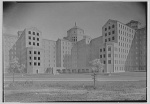Difference between revisions of "Portal:Featured Article Of The Week"
M-Explorer (talk | contribs) |
M-Explorer (talk | contribs) |
||
| Line 1: | Line 1: | ||
{{FAformat | {{FAformat | ||
| − | |Title= | + | |Title= Pilgrim State Hospital |
| − | |Image= | + | |Image= Pilgrimsh1.jpg |
|Width= 150px | |Width= 150px | ||
| − | |Body= | + | |Body= At the time it was opened, it was the largest hospital of any type in the world. Its size has never been exceeded by any other facility, although today Pilgrim is far smaller than it used to be. |
| − | + | By 1900, overcrowding in city asylums was becoming a major problem that many tried to resolve. One answer was to put the mentally ill to work farming in a relaxing setting on what was then rural Long Island. The new state hospitals were dubbed "Farm Colonies" because of their live-and-work treatment programs, agricultural focus and patient facilities. However, these farm colonies, the Kings Park State Hospital (later known as the Kings Park Psychiatric Center) and the Central Islip State Hospital (later known as the Central Islip Psychiatric Center), quickly became overcrowded, just like the earlier institutions they were supposed to replace. | |
| − | + | NY state responded by making plans for a third so-called farm colony, what was to become the Pilgrim State Hospital, named in honor of the former New York State Commissioner of Mental Health, Dr. Charles W. Pilgrim. The state bought up approx. 1,000 acres (4.0 km²) of land in Brentwood and began construction in 1930. The hospital opened on October 1, 1931 as a close knit community with its own police and fire department, courts, post office, a LIRR station, power plant, potter's field, swinery, cemetery, water tower and houses for doctors, psychiatrists, and asylum administrators. A series of underground tunnels were used for routing steam pipes and other vital utilities. [[Pilgrim State Hospital|Click here for more...]] | |
}} | }} | ||
Revision as of 04:45, 3 March 2024
Featured Article Of The Week
Pilgrim State Hospital
At the time it was opened, it was the largest hospital of any type in the world. Its size has never been exceeded by any other facility, although today Pilgrim is far smaller than it used to be.
By 1900, overcrowding in city asylums was becoming a major problem that many tried to resolve. One answer was to put the mentally ill to work farming in a relaxing setting on what was then rural Long Island. The new state hospitals were dubbed "Farm Colonies" because of their live-and-work treatment programs, agricultural focus and patient facilities. However, these farm colonies, the Kings Park State Hospital (later known as the Kings Park Psychiatric Center) and the Central Islip State Hospital (later known as the Central Islip Psychiatric Center), quickly became overcrowded, just like the earlier institutions they were supposed to replace.
NY state responded by making plans for a third so-called farm colony, what was to become the Pilgrim State Hospital, named in honor of the former New York State Commissioner of Mental Health, Dr. Charles W. Pilgrim. The state bought up approx. 1,000 acres (4.0 km²) of land in Brentwood and began construction in 1930. The hospital opened on October 1, 1931 as a close knit community with its own police and fire department, courts, post office, a LIRR station, power plant, potter's field, swinery, cemetery, water tower and houses for doctors, psychiatrists, and asylum administrators. A series of underground tunnels were used for routing steam pipes and other vital utilities. Click here for more...
